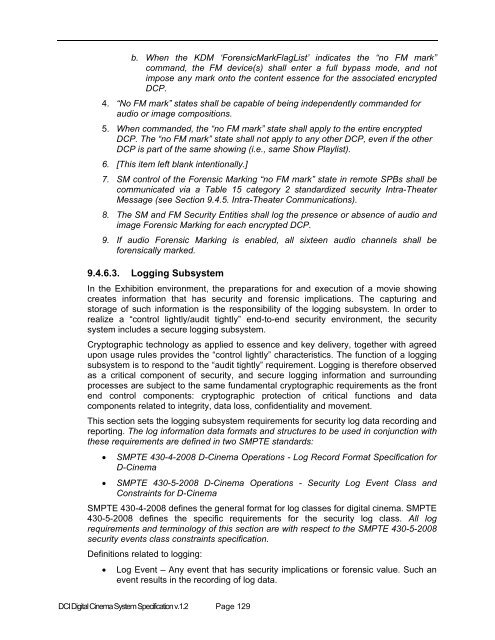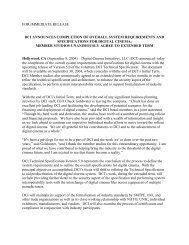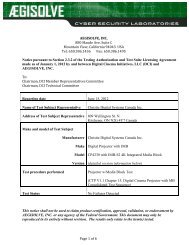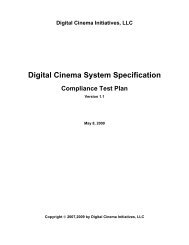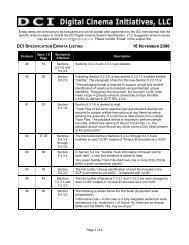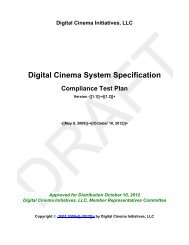DCI Specs - Digital Cinema Initiatives
DCI Specs - Digital Cinema Initiatives
DCI Specs - Digital Cinema Initiatives
Create successful ePaper yourself
Turn your PDF publications into a flip-book with our unique Google optimized e-Paper software.
. When the KDM ‘ForensicMarkFlagList’ indicates the “no FM mark”command, the FM device(s) shall enter a full bypass mode, and notimpose any mark onto the content essence for the associated encryptedDCP.4. “No FM mark” states shall be capable of being independently commanded foraudio or image compositions.5. When commanded, the “no FM mark” state shall apply to the entire encryptedDCP. The “no FM mark” state shall not apply to any other DCP, even if the otherDCP is part of the same showing (i.e., same Show Playlist).6. [This item left blank intentionally.]7. SM control of the Forensic Marking “no FM mark” state in remote SPBs shall becommunicated via a Table 15 category 2 standardized security Intra-TheaterMessage (see Section 9.4.5. Intra-Theater Communications).8. The SM and FM Security Entities shall log the presence or absence of audio andimage Forensic Marking for each encrypted DCP.9. If audio Forensic Marking is enabled, all sixteen audio channels shall beforensically marked.9.4.6.3. Logging SubsystemIn the Exhibition environment, the preparations for and execution of a movie showingcreates information that has security and forensic implications. The capturing andstorage of such information is the responsibility of the logging subsystem. In order torealize a “control lightly/audit tightly” end-to-end security environment, the securitysystem includes a secure logging subsystem.Cryptographic technology as applied to essence and key delivery, together with agreedupon usage rules provides the “control lightly” characteristics. The function of a loggingsubsystem is to respond to the “audit tightly” requirement. Logging is therefore observedas a critical component of security, and secure logging information and surroundingprocesses are subject to the same fundamental cryptographic requirements as the frontend control components: cryptographic protection of critical functions and datacomponents related to integrity, data loss, confidentiality and movement.This section sets the logging subsystem requirements for security log data recording andreporting. The log information data formats and structures to be used in conjunction withthese requirements are defined in two SMPTE standards:• SMPTE 430-4-2008 D-<strong>Cinema</strong> Operations - Log Record Format Specification forD-<strong>Cinema</strong>• SMPTE 430-5-2008 D-<strong>Cinema</strong> Operations - Security Log Event Class andConstraints for D-<strong>Cinema</strong>SMPTE 430-4-2008 defines the general format for log classes for digital cinema. SMPTE430-5-2008 defines the specific requirements for the security log class. All logrequirements and terminology of this section are with respect to the SMPTE 430-5-2008security events class constraints specification.Definitions related to logging:• Log Event – Any event that has security implications or forensic value. Such anevent results in the recording of log data.<strong>DCI</strong> <strong>Digital</strong> <strong>Cinema</strong> System Specification v.1.2 Page 129


